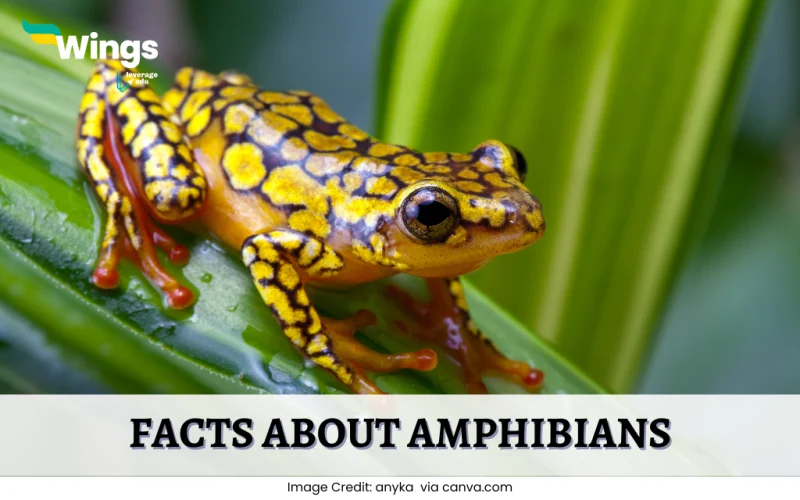Amphibians are unique creatures that can survive in both land and water. They showcase the incredible nature of animals to adapt to their surroundings. Amphibians are animals like caecilians, salamanders, and frogs. Do you want to know some interesting facts about amphibians? You have come to the right page! This blog covers the top 10 facts about amphibians that you didn’t know about.
Table of Contents [show]
10 Fascinating Facts About Amphibians
Amphibians are animals that fill the gap between terrestrial and aquatic life. These are some interesting facts about them. Read these facts and let us know which fact surprised you the most.
1. They Breathe Through Their Skin
One of the most well-known facts about amphibians is that they can breathe through their skin. This means they can survive on land and water. However, for this ability to work they need to ensure that their skin is moist. Therefore, they are sensitive to climate change and pollution.
2. They Go Through Metamorphosis
Another interesting fact about amphibians is that they undergo metamorphosis. They have a dramatic transformation from birth. For example, frogs are born as aquatic tadpoles with gills. However, later on they can develop gills in them. This allows them to walk in the land. This process is called metamorphosis.
3. Many of Them Can Regrow Limbs
Do you know some amphibians can regrow their limbs? You have heard it right. This is one of the facts about amphibians. Amphibians like salamanders can regenerate their body parts, including their heart! Scientists are studying their ability so that they can learn about human tissue regeneration.
4. They Have Cold Blood in Their Bodies
Amphibians are ectothermic or cold-blooded creatures. This means they rely on external temperatures to maintain their body temperature. Therefore, they are more active in places with warm temperatures. On the contrary, they enter their hibernation mode during winter. For example, the American bullfrog can survive the freezing temperatures by making a burrow in the mud. When they are faced with extreme heat, they enter an aestivate state (similar to hibernation).
5. They are Indicators to Assess the Environment
One of the facts about amphibians is that they act as indicators of environmental quality. The skin is permeable and can absorb pollutants. A declining amphibian population means the environment is polluted. It also means that habitat destruction or climate change is happening.
6. Chinese Giant Salamander
The Chinese Giant Salamander is the largest amphibian on the planet. This is another one of the facts about amphibians. The Chinese Giant Salamander can grow up to 6 feet (1.8 meters). It lives in freshwater habitats. However, the animal is critically endangered due to habitat loss. These salamanders have poor eyesight and depend on the vibrations from the water to identify their prey. They are difficult to find as they spend most of their time hidden under rocks in rivers.
7. Wood Frogs Can Freeze and Survive
Certain frogs, like the wood frog,s can freeze yet survive. This is one of the most interesting facts about amphibians. These frogs have adapted to survive during winter. Their bodies can create natural antifreeze. This prevents ice crystals from affecting their organs. During spring, they return to their normal lives.
8. They Have Unique Ways to Communicate
Another interesting fact about amphibians is that they have unique ways to communicate with each other. For example, they will use their color, sound or body movements to communicate. Therefore, frogs have loud croaks to warn rivals or to attract mates. Another example is salmanders. Salamanders can communicate through chemical signals.
9. They Maintain a Double Life
Amphibians are known for maintaining their double life. Another interesting facts about amphibians is that the word amphibian is taken from a Greek word amphibios. This means double life. This means they lead a double life by living in water and on land. Most amphibians start off by living in the water. Thereafter, they live in the land. However, species like the axolotl stay aquatic even though they have developed lungs.
10. They Have 8,000 Species of Amphibians
Amphibians come in many shapes and sizes. For example, there are 8,000 identified species on Earth. These species are categorized into 3 main groups: toads and frogs, salamanders and newts, and caecilians (Gymnophiona). Caecilians are limbless worm-like creatures found in tropical regions.
Amphibians play a significant role in maintaining the ecosystem, and controlling the population of insects. They also serve as food to the larger animals. Sadly, these creatures are threatened by pollution, climate change and habitat destruction..
FAQs
Amphibians have permeable skin. This helps them to keep their skin moist and secret mucous. Hence, they are considered slimy creatures. Besides this, their dermis consists of glands that produce noxious chemicals that help in identifying predators.
90% of amphibians are frogs. The amphibians are categorised into frogs and toads, caecilians, and salamanders.
Amphibians do not have 3 hearts. However, their heart has 3 chambers consisting of one ventricle and two atria. However, the lungless salamander does not have a septum to divide the atrium into two chambers.
This was all about the facts about the law of physics. If you find it fascinating and wish to read more such interesting facts, then stay tuned to the General Knowledge page of Leverage Edu.
 One app for all your study abroad needs
One app for all your study abroad needs















 45,000+ students trusted us with their dreams. Take the first step today!
45,000+ students trusted us with their dreams. Take the first step today!
